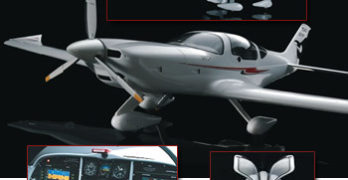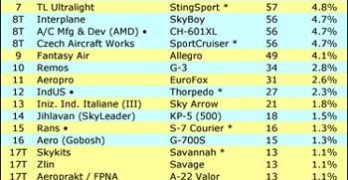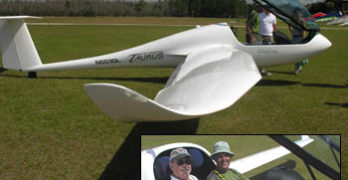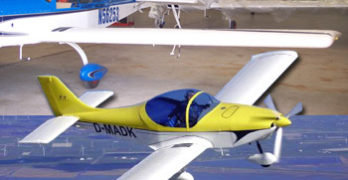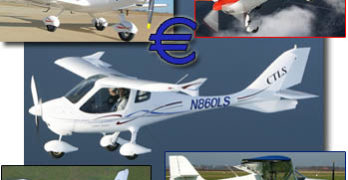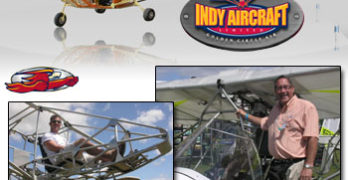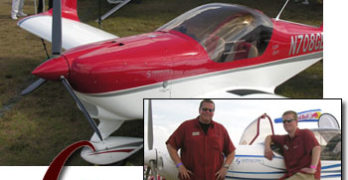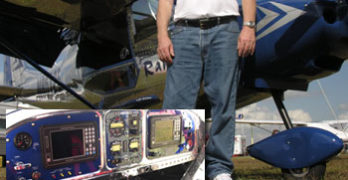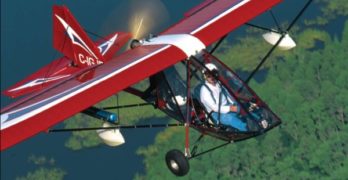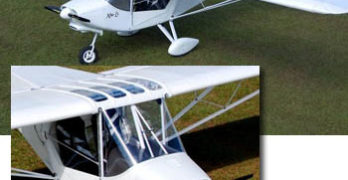In development for years, Composite Aeronautic Group’s Toxo won SLSA airworthiness on March 28th from Mike Millard, FAA. The newest SLSA, number 76, hails from Spain — the second LSA entry from that European country (after the Colyaer Freedom amphib). When Toxo first arrived, Americans were attracted but found it rather small inside. After displaying at American airshows, CAG reengineered Toxo and returned with a variation better suited to Americans (about 45 inches wide, making it more than five inches wider than a Cessna 172). Toxo Aircraft North America representative Amy Christian adds, “Toxo offers easy access with gull-wing doors, great air flow throughout the interior, and cushy seats with just the right angle for optimal comfort. Our pedals are even adjustable for a custom fit.” Toxo wings and fuselage are built using prepreg fiberglass plus carbon fiber with structural honeycomb cores. *** The company is represented in the USA by two companies: Toxo Aircraft North America with the lion’s share of American states, and by ILS Aircraft Company, an operation handling Alabama, Georgia, and the vital Florida market.
2008 LSA Sales Reflect a Stalling U.S. Economy
The U.S. economy is hardly crashing, but while slipping backwards in late 2007 and early 2008, it has been on a bumpy plateau. This unevenness causes trouble for many businesses. Even giant coffee seller, Starbucks, is rejiggering their business model to adjust for folks balking at $4 coffee while their stock portfolio lurches up and down. Light-Sport Aircraft sales also reflect that lack of consumer confidence. *** Figures for the first two months of 2008 show slightly more than 40 aircraft registrations per month. In 2007, the industry averaged 47 aircraft registrations per month. Of course, this 15% decrease also comes while many northern states have endured awful winter flying weather, partially explaining why sales are off the beat. Despite a cloudy overcast some bright spots emerge. *** CZAW‘s SportCruiser led the pack with more than 17% growth during January and February. AMD is close behind with 14% growth, and CubCrafters continues their climb with 7.5% growth.
Rotax 503 Launch…then, Silence is Golden
Some of you know the Pipistrel line. Americans have seen two of their models: the Sinus and Virus (yep, those awkward, even distasteful names…except representatives prefer to say SEEN-us and VEER-us). Fortunately Taurus is easier on the American tongue, thanks to Ford and its auto model by the same name. *** I discovered Taurus is also easy on the ears as I went for a two-hour soaring flight from Wallaby Ranch with my hang gliding friend, David Ledford. His side-by-side Taurus — roomy for a soaring machine — glides beyond 40:1 and manages a sink rate barely more than 100 fpm. Those numbers translate into plenty of soaring power as we proved on a day with modest convective lift. *** Taurus is a self-launched sailplane, rather than a motorglider like Urban Air’s Lambada or Pipistrel’s own Sinus. To get aloft, we were powered by a Rotax 503 two-stroke engine that fits neatly into a cavity aft of the cockpit.
Renewed Breezer II SLSA Ready for Delivery
They are lining up, literally, at Sportsplanes.com’s Plant City, Florida airport (PCM) assembly station. Michael Zidziunas — everyone calls him “Mike Z” — assembled three of the new Breezer II SLSA and arranged for DAR inspection. Mike Z is a well-known flight instructor and licensed mechanic working in the LSA arena. *** Last fall, at the AOPA Expo, Josh Foss of Sportsplanes.com unveiled the new Breezer II. The all-metal low wing was introduced more than a year earlier but disputes over the design rights and manufacturing put a halt to shipments. Since then, German designer Ralf Magnussen found a new investor, Dirk Ketelsen, a builder of windmills for electric power generation. They established a new 17,000 square foot plant near Husum, Germany (west of Hamburg at the North Sea coastline) where Josh reports they can build more than 100 aircraft a year.
High Priced Light-Sport Aircraft; What’s Going On?
Lots of folks are wondering about, or complaining about, the seemingly high prices of Light-Sport Aircraft. Recently a prior editor-in-chief of EAA publications, Scott Spangler, wrote a blog on JetWhine. Scott focused on expensive avionics as one reason LSA cost so much. While a factual observation, I believe the price increase is more complex. *** First, LSA suppliers install equipment like autopilots because buyers ask for them. A large chunk of all LSA are sold to “retiring” GA pilots used to such equipment in their Cessna or Bonanza. Simpler LSA are available; most suppliers have one. But customers are buying the loaded-panel jobs. *** Let’s look closer at those rising prices. Five years ago, in the pre-dawn of SP/LSA, a CT was selling for $60,000. Today it’s $125,000. By far the largest piece of that doubling is the euro’s soaring value compared to the dollar. Were the currencies at parity, that $125,000 would be $80,000.
Ultralights Seek SLSA Approval; May Sell ELSA Kits
Taking a kit aircraft company to full ASTM approval is a very big decision for small companies. Simply assuring you have documents to support a declaration is, by itself, a major task. Then comes a decision about fully building or going the Experimental LSA kit route. A company must first fully build and certify at least one Special LSA, but once done, they can elect to provide a kit only…or to factory build and supply kits. Small shops could fully build 20-30 SLSA and supply additional ELSA kits and parts to make a healthy business. *** We may finally see such entries. Recently I wrote an updated pilot report on the T-Bird I from Indy Aircraft. Boss Bret Kivell said Indy is working on approval. As an ELSA, the single seater could be HKS (four-stroke) powered, which would make it one sweet sport aircraft. Likewise development is underway at Paul Mather’s M-Squared Aircraft where his Sport 1000 could gain SLSA approval later this year.
Two Lovely Low Wings — Gobosh 700 & 800
Out of the blue in 2007. Now, they have two in 2008…SLSA models, that is. Gobosh is the interestingly named company (it’s a tech industry thing) that burst on the AirVenture Oshkosh scene with the Gobosh 700S, a rebadged upgrade of the Aero AT-3 from Poland. Just six months later at the Sebring LSA Expo 2008, Gobosh introduced the super sleek 800XP from the Czech Republic’s Aveko, builder of the speedy retractable VL-3 on which 800XP is based. Relying on their experience with the Symphony and other business ventures partners Dave Graham and Tim Baldwin (inset photo, left) are rapidly expanding their presence in light-sport aviation. *** Their two planes are an interesting contrast. Gobosh promotes the metal 700S as a “luxury sport aircraft,” though it seems well aimed at flight schools. The composite 800XP is the high performance model, “which had to be slowed down for LSA rules,” said Dave.
On the Rampage…Yet Another SLSA from Skykits
Rampage looks so dissimilar to its predecessors from Skykits that it took a second glance to make the connection. While it shares the STOL wing devices with versions of the Savannah, Rampage has a sleeker look that might broaden the appeal of these short takeoff and land designs from ICP of Italy. *** For those who got to see the new model at Sebring the airplane’s lines weren’t alone to admire. Deep blue paint was used in strategic accent to highly polished aluminum on most of the fuselage; Rampage gleamed brilliantly in Florida’s warm sun. The finish was brought inside where a polished aluminum instrument panel frame contrasted with royal blue inset subpanels (photo). Skykits director Eric Giles reported that the bright metal inside had not caused reflective problems on their long flight from western Canada. *** Rampage, the fourth SLSA model for which Skykits has gained airworthiness, uses electrically deployed leading edge slats to continue the impressive performance of the Savannah models.
Lightplane Offerings From Canada
The Beaver and Chinook ultralight-like aircraft are arguably two of the bestknown
lightweight designs coming from Canada. Aircraft Sales and Parts, more
commonly known as ASAP, is the company that rescued and now manufactures
and sells these designs, along with a powered parachute from its sister company,
Summit Powered Parachutes. The tale of ASAP’s involvement with the Chinook
and Beaver offers insight into ultralight progress – Canadian style.
A History Lesson
Perhaps the most famous ultralight
to come out of Canada is the Beaver.
With a reported 2,200 flying units
since the early 1980s, it’s a successful
design. However, due to corporate
missteps by the companies that
owned the brand, the Beaver series
was nearly lost. Originally, the Beaver
models were manufactured by
Spectrum Aircraft Inc. Reorganization
left the ultralight in the hands
of a company called Beaver RX Enterprises.
In 1993, that company closed
its doors and stranded thousands of
Beaver aircraft owners, along with
all the dealerships that sold and serviced
them.
X-Air’s Return Brings Lowest-Cost SLSA
Upon seeing modern LSA, many aviators say, “Oh, these aren’t ‘those ultralights’ at all.” Truth be told, even those ultralights aren’t ultralights any more. Today, a certified but ultralight-like aircraft will be either Special or Experimental LSA. *** Witness what I’ll call the “return” of the X-Air. I’ve reported on this design as it has evolved (see photo legend). Astute visitors may recognize X-Air LS as an evolution of the pioneering Weedhopper, though little of the original design remains. The latest iteration of this venerable design is working to gain SLSA airworthiness. X-Air founder and designer, Joel Koechlin, has three decades of experience in light aircraft. His X-Air series has been a mainstay among European microlights for 15 years, selling more than 1,200 copies. *** The coming SLSA model employs the 85-hp Jabiru 2200 powerplant. Koechlin said, “This aircraft is exactly what the LSA category was meant for; it is light and easy to fly and simply fun!” U.S.
- « Previous Page
- 1
- …
- 48
- 49
- 50
- 51
- 52
- …
- 64
- Next Page »


